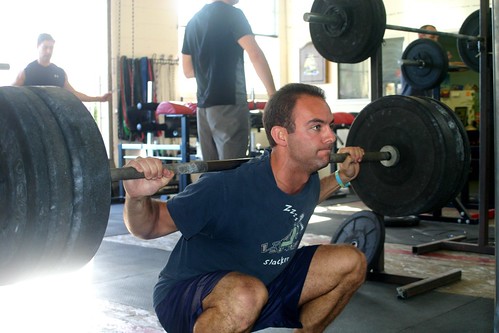The highs and lows of it all.
Tuesday, September 18, 2012
Mobility:
Hip prep
Strength:
High Bar Back Squat, 2×8 at 65%, 2×5 at 70%, 1×5 at 75%- rest 2 minutes between sets.
*Percentages based off 1 RM
Workout:
5-4-3-2-1 reps of:
Clean and Jerk (185/120)
Muscle ups
Notes: This workout can be scaled to 10-8-6-4-2 reps of a lighter weight and chest-to-bar or regular pull-ups.
Cool down:
Easy 400 meter jog
Accumulate 1-2 minutes in German hang
2 minute per side of Quad on Wall

 Torso position in the high bar position mimics the receiving position of the olympic lifts, like the snatch.
Torso position in the high bar position mimics the receiving position of the olympic lifts, like the snatch.
High bar. Low bar. Is there a difference? Do I care? Should I care? Isn’t all squatting the same? Make no mistake, all that really matters is that you’re squatting. I get asked this a lot and I’ve listed a couple of resources (get these to the resource library, STAT!) that should clear things up. A very succinct and straight-forward look at the two squat techniques can be found here. For those that would rather watch a video, I’ve included that as well. Both will take about the same time BTW and are worth checking out. The short of it is that while the low bar back squat, or as it’s known in some circles, the “power squat”, put a premium on training the posterior chain and is great for overall strength in athletes and powerlifters, the high bar back squat, also referred to as the “olympic squat”, is the squat of choice for you guessed it, olympic lifters. This is obvious when you look at the receiving position of a clean or snatch and that the ability to squat out of a very deep hole while maintaining a very upright body position is critical. Do them both, do them well, and do them often.
The Back Squat from Again Faster on Vimeo.















